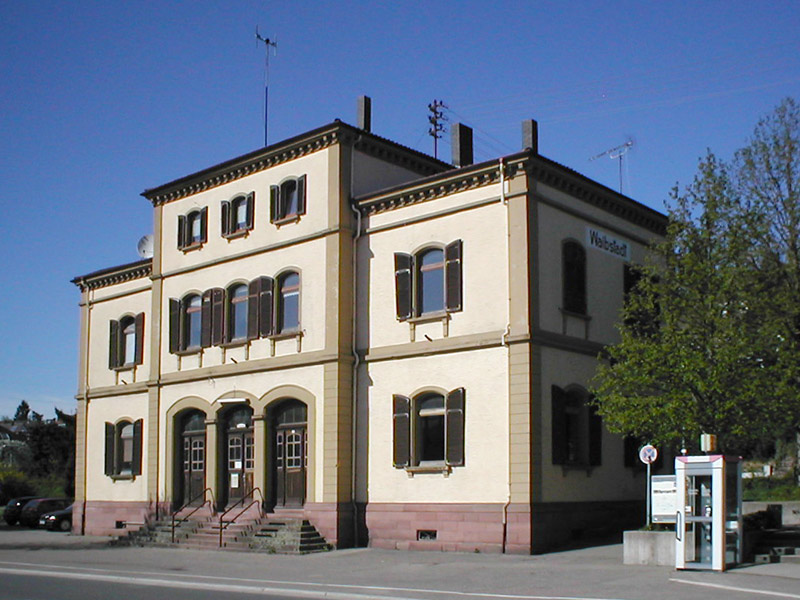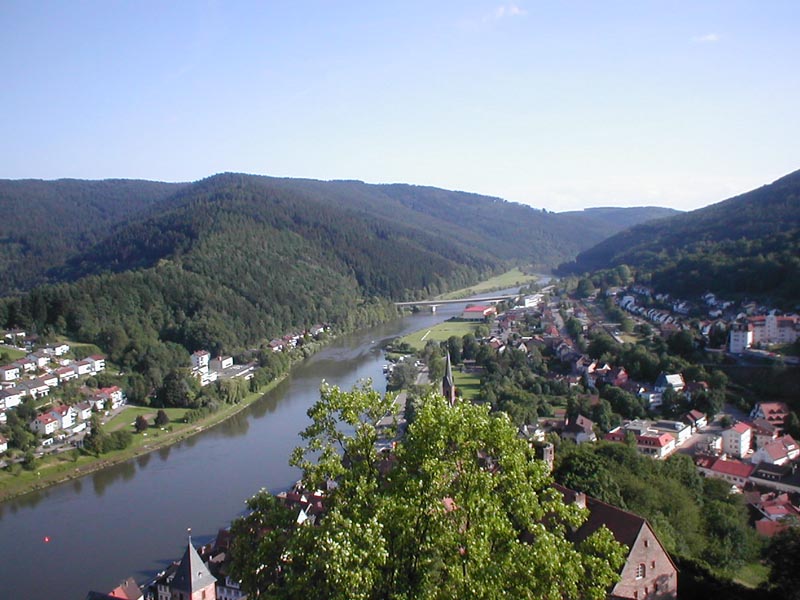|
Meckesheim–Neckarelz Railway
The Meckesheim–Neckarelz railway is a branch line in northern Baden between Meckesheim and Aglasterhausen that used to run to Neckarelz. It was part of the former Baden Oldenwald Railway from Heidelberg to Würzburg, and thus a main line, which is why its trackbed was built for two tracks. The section remaining today also goes under the name of Schwarzbach Valley Railway (german: Schwarzbachtalbahn). Route The line runs on the border between the ''Kleiner Odenwald'' ("Little Odenwald") and the Kraichgau regions. It is also now known as the Schwarzbach Valley Railway (''Schwarzbachtalbahn'') as the remaining section of the line follows the Schwarzbach, a right tributary of the Elsenz river. It also has no major engineering structures because it runs consistently in the valley between Meckenheim and Aglasterhausen. The now disused section between Aglasterhausen and Neckarelz had more difficult topographical conditions, however, so a total of three tunnels were built. The namin ... [...More Info...] [...Related Items...] OR: [Wikipedia] [Google] [Baidu] |
Meckesheim
Meckesheim is a village in south western Germany. It is located between Heidelberg and Sinsheim in the Rhein-Neckar district in the state of Baden-Württemberg. History In 772 and 822 Meckesheim was mentioned for the first times as ''Heim des Mechino'' (''home of Mechino'') or ''Mechinos Heim'' (''Mechino's home'') in the Codex of Lorsch. The Martin's Chappel which ruins are east of the village is one of the oldest churches in the region. Since 1330 Meckesheim and the villages around was a part of the Electorate of the Palatinate. After the end of this territory in 1803 the village became a part of Baden. Traffic (rail) Meckesheim station is connected via the Badenese Odenwald line from Heidelberg (1862, northwestern of Meckesheim) to Mosbach (Baden) (eastwards, 1862) and Würzburg (completed 1866). In 1868, a branch to Bad Rappenau (southeast of Meckesheim, important for salt production in Baden) was added and in 1869 completed to Bad Friedrichshall, in this way there were no ... [...More Info...] [...Related Items...] OR: [Wikipedia] [Google] [Baidu] |
Neckarelz–Osterburken Railway
The Neckarelz–Osterburken railway is a 30.9 km long railway line in the north of the German state of Baden-Württemberg, which connects the Neckar and the Bauland along the edge of the Odenwald. It was opened in 1866 as part of the Odenwald Railway (Baden) (''Odenwaldbahn'') between Heidelberg and Würzburg. It has been upgraded to form an entirely double-track and electrified main line railway. It was an east–west axis for German long-distance transport until 1945. Since 2003 passenger services on it have been operated by the Rhine-Neckar S-Bahn. The Neckarelz–Mosbach section has also been served by the Heilbronn Stadtbahn since 2014. Route The track today starts at Mosbach-Neckarelz station, where the Neckar Valley Railway branches off. Until about 1960 there was a connecting curve from Mosbach to Hochhausen on the Neckar Valley Railway. Until 1895, the old route of the Odenwald Railway from Obrigheim connected before the line reaches the current site of the Mosb ... [...More Info...] [...Related Items...] OR: [Wikipedia] [Google] [Baidu] |
Bundesstraße 292
''Bundesstraße'' (German for "federal highway"), abbreviated ''B'', is the denotation for German and Austrian national highways. Germany Germany's ''Bundesstraßen'' network has a total length of about 40,000 km. German ''Bundesstraßen'' are labelled with rectangular yellow signs with black numerals, as opposed to the white-on-blue markers of the ''Autobahn'' controlled-access highways. ''Bundesstraßen'', like autobahns, are maintained by the federal agency of the Transport Ministry. In the German highway system they rank below autobahns, but above the ''Landesstraßen'' and ''Kreisstraßen'' maintained by the federal states and the districts respectively. The numbering was implemented by law in 1932 and has overall been retained up to today, except for those roads located in the former eastern territories of Germany. One distinguishing characteristic between German ''Bundesstraßen'' and ''Autobahnen'' is that there usually is a general 100 km/h (62 mph) spe ... [...More Info...] [...Related Items...] OR: [Wikipedia] [Google] [Baidu] |
Schwarzbach (Kraichgau)
Schwarzbach is a river of Baden-Württemberg, Germany. It flows into the Elsenz in Meckesheim. See also *List of rivers of Baden-Württemberg A list of rivers of Baden-Württemberg, Germany: A * Aal * Aalbach *Aalenbach * Ablach * Ach *Acher *Adelbach *Aich *Aid * Aischbach, tributary of the Kinzig * Aischbach, tributary of the Körsch * Aitrach, tributary of the Danube * Aitrach, tri ... References Rivers of Baden-Württemberg Rivers of Germany {{BadenWürttemberg-river-stub ... [...More Info...] [...Related Items...] OR: [Wikipedia] [Google] [Baidu] |
Kraichgau
The Kraichgau () is a hilly region in Baden-Württemberg, southwestern Germany. It is bordered by the Odenwald and the Neckar to the North, the Black Forest to the South, and the Upper Rhine Plain to the West. To the east, its boundary is considered to be the Stromberg and the Heuchelberg. The largest towns of the Kraichgau are Sinsheim, Eppingen, and Bretten. On the western end of the Kraichgau is the town of Bruchsal, the gateway to the Rhineland plains. Origins of the name The word "Kraich" apparently arose from the Celtic word "Creuch," meaning "mud" or "loam." The territory of a Gau (country subdivision) signifies an open area, free from woods, such as farmland or meadows. The area of Kraichgau was first mentioned in the Early Middle Ages, in the Lorsch codex, as "Creichgowe" in the year 769. In 773, it was called "Chrehgauui," in 778 "Craichgoia." By 1594, the name was closer to its modern form, being referred to as "Kreuchgau." See also *Aalkistensee Aalk ... [...More Info...] [...Related Items...] OR: [Wikipedia] [Google] [Baidu] |
Odenwald
The Odenwald () is a low mountain range in the German states of Hesse, Bavaria and Baden-Württemberg. Location The Odenwald is located between the Upper Rhine Plain with the Bergstraße and the ''Hessisches Ried'' (the northeastern section of the Rhine rift) to the west, the Main and the Bauland (a mostly unwooded area with good soils) to the east, the Hanau-Seligenstadt Basin – a subbasin of the Upper Rhine Rift Valley in the Rhine-Main Lowlands – to the north and the Kraichgau to the south. The part south of the Neckar valley is sometimes called the ''Kleiner Odenwald'' ("Little Odenwald"). The northern and western Odenwald belong to southern Hesse, with the south stretching into Baden. In the northeast, a small part lies in Lower Franconia in Bavaria. Geology The Odenwald, along with other parts of the Central German Uplands, belongs to the Variscan, which more than 300 million years ago in the Carboniferous period ran through great parts of Europe. The cause ... [...More Info...] [...Related Items...] OR: [Wikipedia] [Google] [Baidu] |
Kleiner Odenwald
The Kleiner Odenwald (“Little Odenwald”) is the southern part of the central German hill range, the Odenwald, and is up to .{{GeoQuelle, DE, BFN-Karten It is also part of the natural region of Sandstein-Odenwald in the north of the state of Baden-Württemberg. Lying east-southeast of Heidelberg and south of the River Neckar, which separates the Kleiner Odenwald from the rest of the Odenwald, its landscape is shaped by the underlying sandstone that also dominates the northern Odenwald. Geography Location The Kleiner Odenwald lies in the counties of Rhein-Neckar and Neckar-Odenwald and on the territory of the city of Heidelberg. It is bounded in the north by the Neckar and the settlements of Neckargemünd and Eberbach, in the east by the Neckar and e.g. by Obrigheim, in the south by Reichartshausen, Waibstadt and Eschelbronn and in the west by Wiesloch, Leimen and Heidelberg on the River Neckar. Municipalities in the area are: Lobbach, Bammental, Gaiberg, Wiesen ... [...More Info...] [...Related Items...] OR: [Wikipedia] [Google] [Baidu] |
Haltepunkt Neckarbischofsheim Nord
A railway stop is a spot along a railway line, usually between stations or at a seldom-used station, where passengers can board and exit the train. While a junction or interlocking usually divides two or more lines or routes, and thus has remotely or locally operated signals, a station stop does not. A station stop usually does not have any tracks other than the main tracks, and may or may not have switches (points, crossovers). The exact definition depends on national legal and operational provisions, which is why ' are usually classified as less important access points, which are often - but not necessarily - poorly accessible to passengers. Germany In Germany, a (abbreviation: ) is a railway facility at which passengers can board or leave trains, i.e. an access point for travellers. In contrast to a ', a ' does not necessarily have railroad switches. There are exceptions, however, if it is locally connected to another service point. The important operational difference ... [...More Info...] [...Related Items...] OR: [Wikipedia] [Google] [Baidu] |
Main Line (railway)
The main line, or mainline in American English, of a railway is a track that is used for through trains or is the principal artery of the system from which branch lines, yards, sidings and spurs are connected. It generally refers to a route between towns, as opposed to a route providing suburban or metro services. It may also be called a trunk line, for example the Grand Trunk Railway in Canada, the Trunk Line in Norway, and the Trunk Line Bridge No. 237 in the United States. For capacity reasons, main lines in many countries have at least a double track and often contain multiple parallel tracks. Main line tracks are typically operated at higher speeds than branch lines and are generally built and maintained to a higher standard than yards and branch lines. Main lines may also be operated under shared access by a number of railway companies, with sidings and branches operated by private companies or single railway companies. Railway points (UK) or switches (US) are usuall ... [...More Info...] [...Related Items...] OR: [Wikipedia] [Google] [Baidu] |
Würzburg
Würzburg (; Main-Franconian: ) is a city in the region of Franconia in the north of the German state of Bavaria. Würzburg is the administrative seat of the ''Regierungsbezirk'' Lower Franconia. It spans the banks of the Main River. Würzburg is situated approximately east-southeast of Frankfurt am Main and approximately west-northwest of Nuremberg (). The population (as of 2019) is approximately 130,000 residents. The administration of the ''Landkreis Würzburg'' ( district of Würzburg) is also located in the town. The regional dialect is East Franconian. History Early and medieval history A Bronze Age (Urnfield culture) refuge castle, the Celtic Segodunum,Koch, John T. (2020)CELTO-GERMANIC Later Prehistory and Post-Proto-Indo-European vocabulary in the North and West p. 131 and later a Roman fort, stood on the hill known as the Leistenberg, the site of the present Fortress Marienberg. The former Celtic territory was settled by the Alamanni in the 4th or 5th century ... [...More Info...] [...Related Items...] OR: [Wikipedia] [Google] [Baidu] |
Heidelberg
Heidelberg (; Palatine German language, Palatine German: ''Heidlberg'') is a city in the States of Germany, German state of Baden-Württemberg, situated on the river Neckar in south-west Germany. As of the 2016 census, its population was 159,914, of which roughly a quarter consisted of students. Located about south of Frankfurt, Heidelberg is the List of cities in Baden-Württemberg by population, fifth-largest city in Baden-Württemberg. Heidelberg is part of the densely populated Rhine-Neckar, Rhine-Neckar Metropolitan Region. Heidelberg University, founded in 1386, is Germany's oldest and one of Europe's most reputable universities. Heidelberg is a Science, scientific hub in Germany and home to several internationally renowned #Research, research facilities adjacent to its university, including the European Molecular Biology Laboratory and four Max Planck Society, Max Planck Institutes. The city has also been a hub for the arts, especially literature, throughout the centurie ... [...More Info...] [...Related Items...] OR: [Wikipedia] [Google] [Baidu] |







